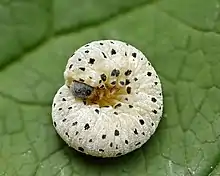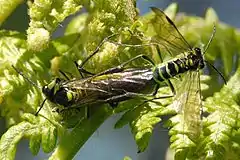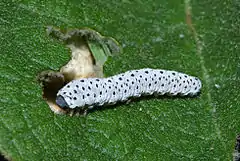Tenthredo scrophulariae
Tenthredo scrophulariae, the figwort sawfly is a species of the family Tenthredinidae, subfamily Tenthredininae.
| Tenthredo scrophulariae | |
|---|---|
.JPG.webp) | |
| Scientific classification | |
| Kingdom: | |
| Phylum: | |
| Subphylum: | |
| Class: | |
| Order: | |
| Family: | |
| Genus: | |
| Species: | T. scrophulariae |
| Binomial name | |
| Tenthredo scrophulariae Linnaeus, 1758 | |
| Synonyms | |
| |
Distribution and habitat

This species is widespread across Europe,[1] Turkey and Transcaucasia,[2][3] in meadows wherever Figwort grows.[4]
Description
Tenthredo scrophulariae can reach a body length of approximately 11–15 millimetres (0.43–0.59 in).[4] It is easily recognisable by its wasplike appearance although lacking the thin 'waist' of a true wasp. The head is black and quite short, with prominent, rectangular back corners. The flagellum of the antennae is not narrowed on the tip, it is quite short (less than twice as long as the head width) compared to many related species. It is orange colored, while in most similar species of the genus it is black. The thorax is predominantly black, only the pronotum and scutellum are yellow. The abdomen is black, with transverse bands of yellow.[5]
The leading edge of the forewings, including the veins, is intense orange-red colored, while the remaining wing-membrane is transparent pale yellowish, gray tinted towards the tip. The front legs are almost completely yellow, but the upper sides of the femurs are black. The middle and the rear legs are orange, but the femurs of the rear legs completely black. In the middle leg pair, the femurs may be completely black or with only black rear sides.
The rather large larvae may reach a length of about 30 millimeters. They have a dark head, with a dusty greyish-white and black-spotted body.
Biology
The larvae feed from August to September. They hibernate on October. The adults are on the wing from May to August of the following year. These sawflies are quite placid and allow close observation. They fly in a lazy style with their long yellow legs hanging down. The adults feed on small insects and can be often found on umbellifers (Heracleum sphondylium),[4] feeding on nectar and pollen. The larvae[6] feed primarily on leaves of Figwort, (Scrophularia).[7][8]
They also occur on Buddleja and on black mullein (Verbascum nigrum), where they feed only on the less hairy, older leaves.[9]
The larvae are parasitized by various parasitoid species of Ichneumonidae (Mesoleptidea prosoleuca and Euceros serricornis).[4][9]
Gallery
 Mating
Mating Larva
Larva Close-up on a wing
Close-up on a wing Imago
Imago
References
- Fauna Europaea
- R.B. Benson Hymenoptera from Turkey
- Önder Calmasur, Hikmet Özbek (2004): A Contribution to the Knowledge of the Tenthredinidae (Symphyta, Hymenoptera) Fauna of Turkey. Part I: The Subfamily Tenthredininae. Turkish Journal of Zoology 28: 37-54.
- James K. Lindsey The Ecology of Commanster
- Thomas Brown The Zoologist's Text-Book, Volume 1
- Tenthredo Scrophulariae, Biolib.cz, retrieved 26 June 2012
- Figwort Sawfly, Naturespot, retrieved 26 June 2012
- Peter A. Hambäck, Johan P. Dahlgren, Petter Andersson, Sonja G. Rabas, Riccardo Bommarco, Johan Ehrlén (2011): Plant Trait-Mediated Interactions between Early and Late Herbivores on Common Figwort (Scrophularia nodosa) and Effects on Plant Seed Set. Ecoscience 18(4): 375-381
- A.D. Liston (2010): New hostplant records for European sawflies (Hymenoptera, Tenthredinidae). Entomologist's Monthly Magazine Vol. 146 No. 1754: 189-193.
- R.R. Benson: Hymenoptera 2. Symphyta, Section b. Handbook for the identification of British insects Vol. VI Part 2b. Published by the Royal Entomological Society of London. 1952
External links
| Wikispecies has information related to Tenthredo scrophulariae. |
| Wikimedia Commons has media related to Tenthredo scrophulariae. |
- LES TENTHREDES at Aramel.free (in French)